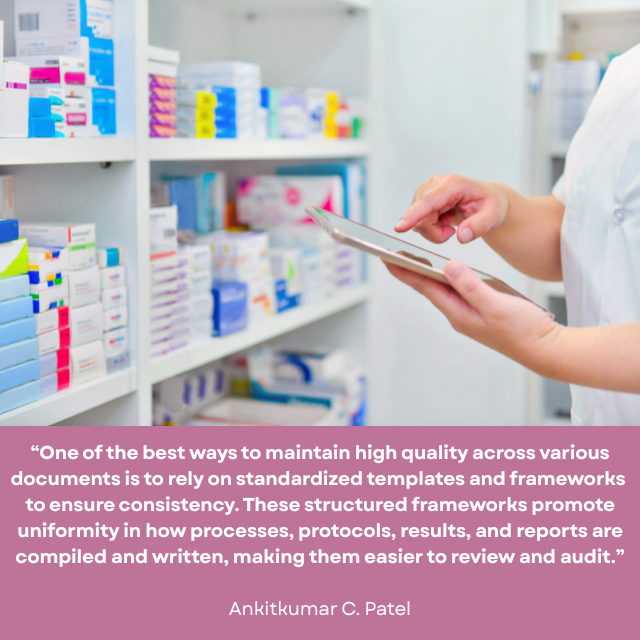October is American Pharmacists Month, a time to celebrate the hard work and dedication of pharmacists across the country. But beyond dispensing medications and offering expert advice, pharmacists also play a crucial role in maintaining high standards of practice. And one of the often-overlooked aspects of their work is the importance of clear, concise documentation, policies, and procedures.
Accuracy and safety are paramount in the industry, and good documentation is a necessity. Let’s dive into why technical writing is so essential for pharmacists and how well-crafted documents can make a real difference in the quality of care they provide.

Why Documentation Matters in Pharmacy
Pharmacists are responsible for ensuring the correct medications are prescribed and dispensed, and that patients understand how to use them. Proper documentation helps ensure this happens smoothly and safely. Here’s why it’s so crucial:
- Patient Safety: A pharmacist’s documentation includes prescription details, dosage instructions, and drug interactions. This information ensures that patients receive the right medications at the right times. Without clear records, it’s easy for mistakes to happen, leading to potential harm.
- Legal Protection: Well-documented procedures and prescriptions protect both pharmacists and their employers from legal liabilities. If something goes wrong, detailed records can serve as evidence of due diligence and proper procedures being followed.
- Regulatory Compliance: Pharmacists work in a highly regulated environment. Clear documentation helps ensure compliance with local, state, and federal laws, such as controlled substance handling, patient privacy regulations (like HIPAA), and safe drug disposal practices.
- Consistency Across Teams: In larger pharmacies or hospitals, pharmacists often work with a team of other healthcare professionals. Clear policies and procedures help standardize practices, ensuring everyone on the team is on the same page when it comes to medication dispensing and patient care.
The Role of Policies and Procedures in Pharmacy
Every pharmacy operates with a set of rules and guidelines to ensure things run smoothly and safely. These policies and procedures are the backbone of the operation, helping staff understand their roles and how to handle various situations.
Here’s a closer look at why well-written policies and procedures are vital:
- Streamlining Processes: Detailed procedures make sure that tasks, like filling prescriptions or checking for drug interactions, are done consistently. With a step-by-step guide in place, pharmacists don’t have to rely on memory or guesswork, which reduces the chances of errors.
- Training New Staff: New hires need to quickly learn the ropes. Comprehensive procedures act as training manuals for new pharmacists, technicians, and other staff members. They’ll know exactly what steps to take and how to troubleshoot issues that arise.
- Ensuring Best Practices: Policies are the best way to ensure that pharmacists follow up-to-date practices. Whether it’s managing inventory, performing patient consultations, or handling adverse drug reactions, clear guidelines help pharmacists adhere to industry standards and provide the highest level of care.

Technical Writing: More Than Just a “Paper Trail”
Technical writing in the pharmacy world isn’t just about having a paper trail; it’s about clear, effective communication that ensures everyone—from pharmacists to patients—is on the same page. Here’s how to approach it:
- Clear and Concise Language: Whether writing patient instructions or internal procedures, clarity is essential. Use simple, direct language that leaves no room for confusion. For example, instead of saying “administer a single dose of 500 milligrams every 24 hours,” say, “take one 500 mg tablet once per day.”
- Use Visuals When Appropriate: Sometimes a diagram or flowchart can make a complex procedure much easier to follow. For example, a flowchart explaining the steps for handling a prescription error can be a lifesaver in a busy pharmacy.
- Maintain Accuracy and Precision: Even small mistakes in pharmaceutical documentation can lead to big problems. A misplaced decimal, missing drug interaction warning, or unclear instruction can result in severe consequences. Always double-check your documentation for accuracy.
- Use Templates for Consistency: Templates for common processes (like patient counseling scripts or prescription order forms) help ensure consistency. This ensures that all patients get the same level of care, regardless of which pharmacist is working that day.
- Regular Updates: Pharmacy practices, medication guidelines, and laws change frequently. It’s essential to regularly update your documentation to reflect the latest information. For instance, dosage guidelines might change or a new drug might be introduced that interacts with existing medications.
Key Documents Pharmacists Use
Let’s break down some of the key documents and types of writing that pharmacists encounter regularly:
- Medication Orders: These are detailed records that include the drug’s name, dosage, and instructions. It’s critical that this documentation is clear to prevent confusion or mistakes when dispensing medications.
- Patient Counseling Sheets: These documents outline medication instructions for patients, including potential side effects, how to take the medication, and any follow-up steps. Well-written counseling sheets ensure patients are well-informed, reducing the likelihood of misuse.
- Inventory Control Logs: Managing medications, especially controlled substances, requires precise record-keeping. Inventory logs track the movement of medication in and out of the pharmacy, ensuring everything is accounted for.
- Incident Reports: When something goes wrong—whether it’s a prescription error, a patient reaction, or a delivery mishap—an incident report documents what happened, how it was resolved, and how to prevent it in the future.
Final Thoughts
American Pharmacist Month isn’t just about celebrating the essential service that pharmacists provide in the community. It’s also about acknowledging the critical role that proper documentation plays in their success. With accurate, clear policies and procedures, pharmacists can provide top-notch care, keep patients safe, and ensure compliance with regulations.
So, whether you’re a pharmacist looking to fine-tune your documentation skills, or a business leader in the pharmacy world aiming to support your team with effective documentation, remember: clear writing ensures everyone’s safety and success. Happy American Pharmacist Month! Here’s to the pharmacists who make it all happen, one prescription at a time.
Related Blogs
Reducing Cognitive Load with Better Documentation: Lessons from I-O Psychology
How Documentation Anchors Distributed Teams (and Keeps Us from Drifting into Chaos)
Warning: Do Not Drink! The Importance of Clear Water Quality Documentation
References
Patel, Ankitkumar C. “Technically Speaking: Quality Documentation is One of the Best Ways to Boost Performance.” 11/26/24. Accessed 8/22/25. https://www.pharmaceuticalcommerce.com/view/quality-documentation-boost-performance
“Documentation: Essential to a Patient’s Continuity of Care.” Pharmacy Connection. Fall 2018. Accessed 8/22/25. https://pharmacyconnection.ca/pharmacy-documentation-fall-2018/
